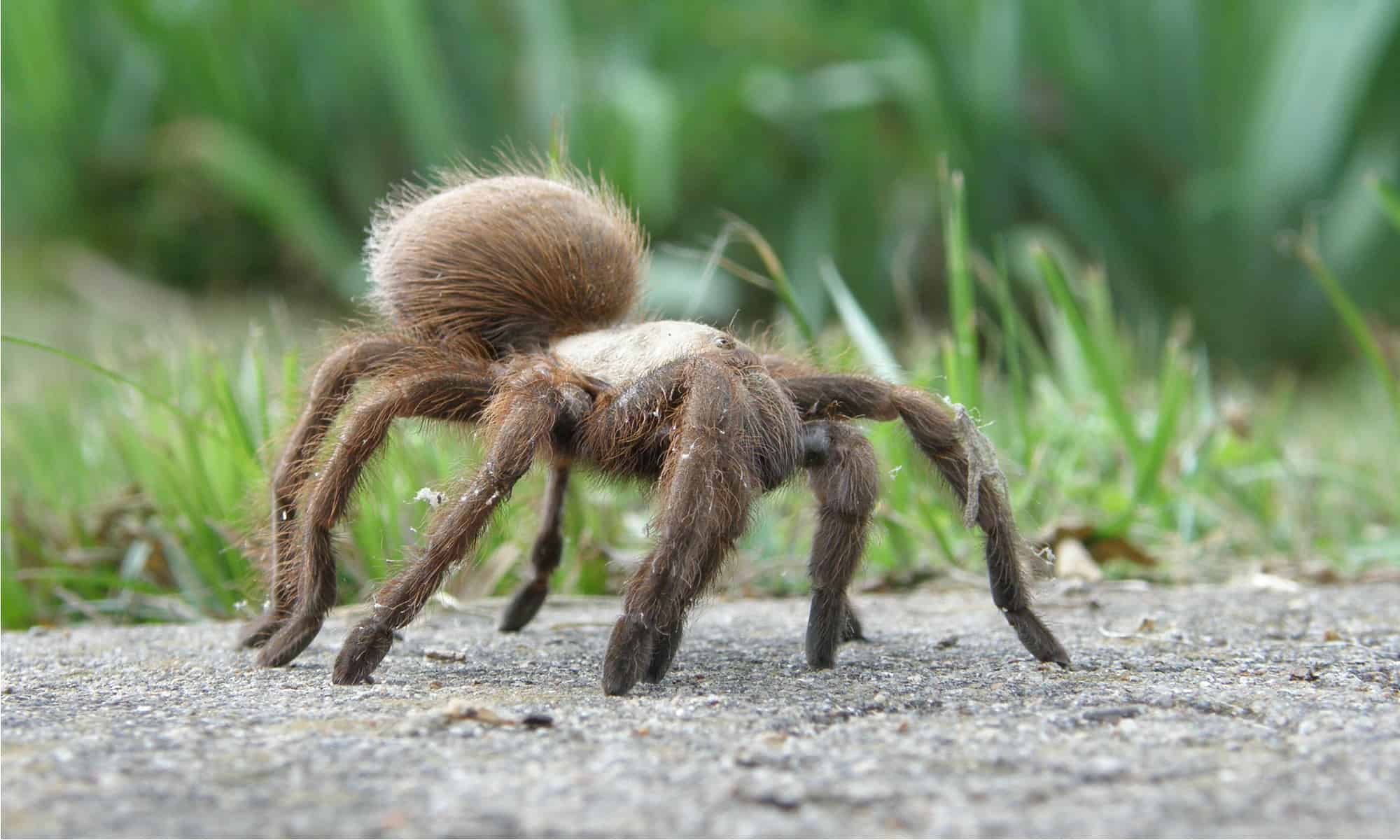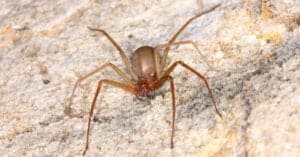While Oklahoma has a rich history, it’s well-known in the modern-day because of its incredible agriculture industry. All those fields with cows and corn are also home to spiders. Today, we are going to focus on the big arachnids. In this article, we’ll showcase five of the biggest spiders in Oklahoma and tell you what they’re all about.
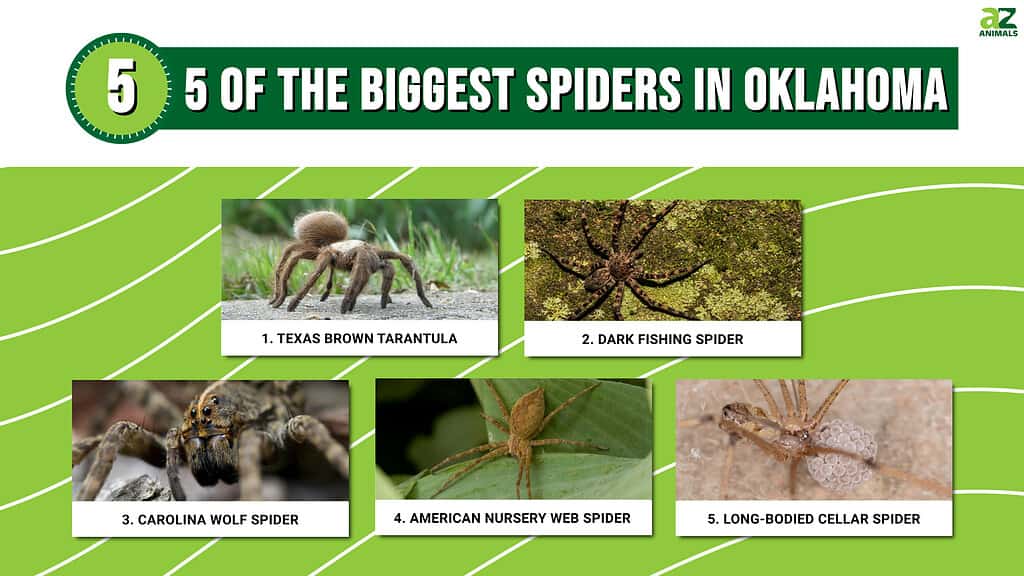
What Are the Biggest Spiders in Oklahoma?
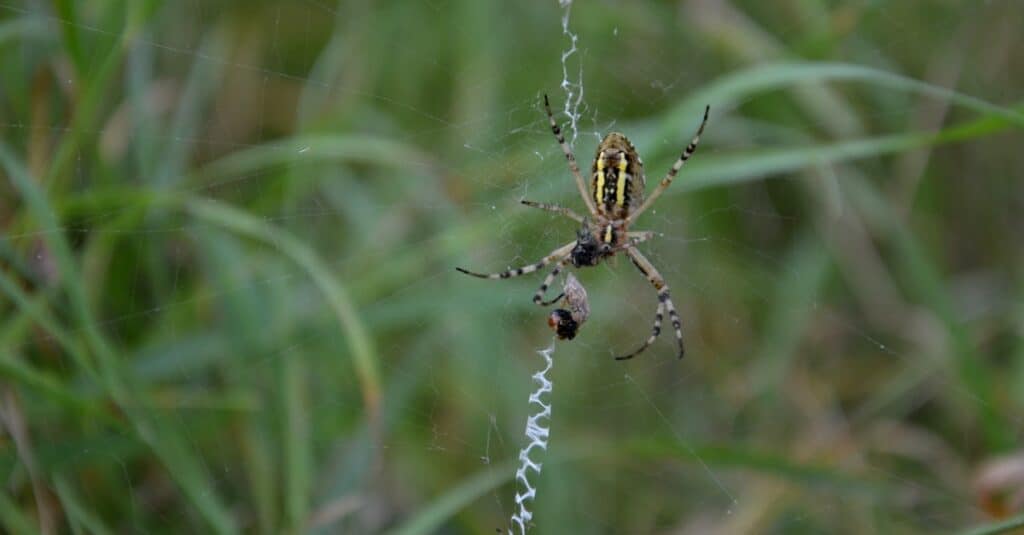
Writing spiders have a unique web with a thick section.
©Beekeepx/Shutterstock.com
We’ve compiled a list of the biggest spiders in Oklahoma. These creatures all measure 2 inches or more by their total size, including their leg length. Not only will you see how big these spiders get, but you’ll also learn about what they look like and if they are dangerous to humans if they bite. You’ll learn why you shouldn’t worry about an encounter with most big spiders, but also which ones should be avoided.
5. Long-Bodied Cellar Spider
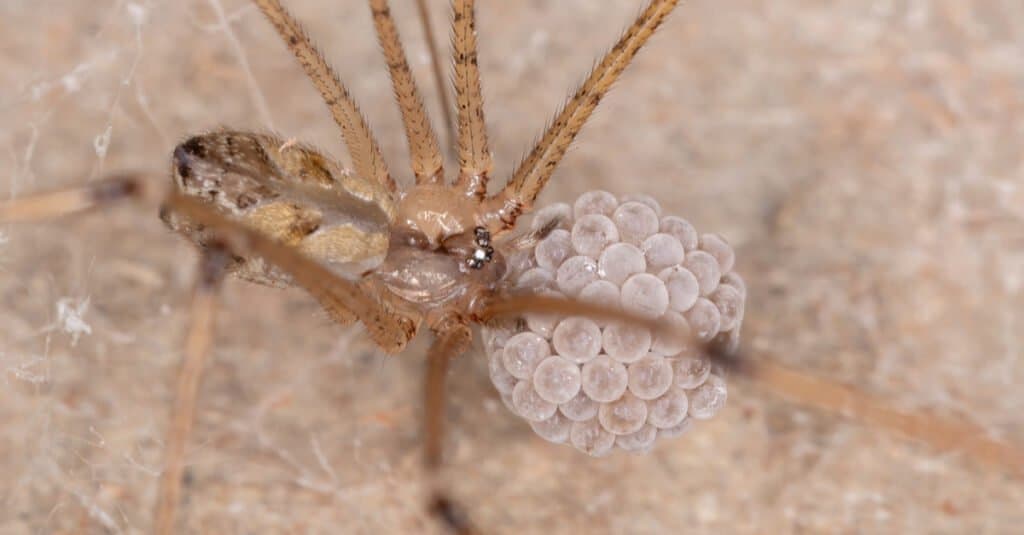
Cellar spiders may look scary, but they’re harmless.
©iStock.com/ViniSouza128
| Scientific Name | Size | Danger to Humans |
|---|---|---|
| Pholcus phalangioides | 1-2 inches | A bite may cause a mild burning sensation. |
The long-bodied cellar spider is very common in many parts of the United States. You can find this species in dark recesses where it is most likely to be left alone. That includes cellars, warehouses, attics, garages, and outbuildings.
The spider has a small cephalothorax and a large, bulbous, and cylindrical abdomen. It is often tan, grayish brown, or brown with a dark mark on the carapace. Its long legs, a habit of making its web vibrate when threats are near, and common name makes people afraid of them.
Cellar spiders are often called the daddy long legs spider. However, that name is also reserved for the harvestman arachnids. Some people insist that the daddy long legs are a dangerous species that just can’t bite human flesh. Cellar spiders can bite, but they’re not dangerous. Instead, you’ll probably have a slight burning pain at the bite site, but they will do their utmost to avoid you.
4. American Nursery Web Spider
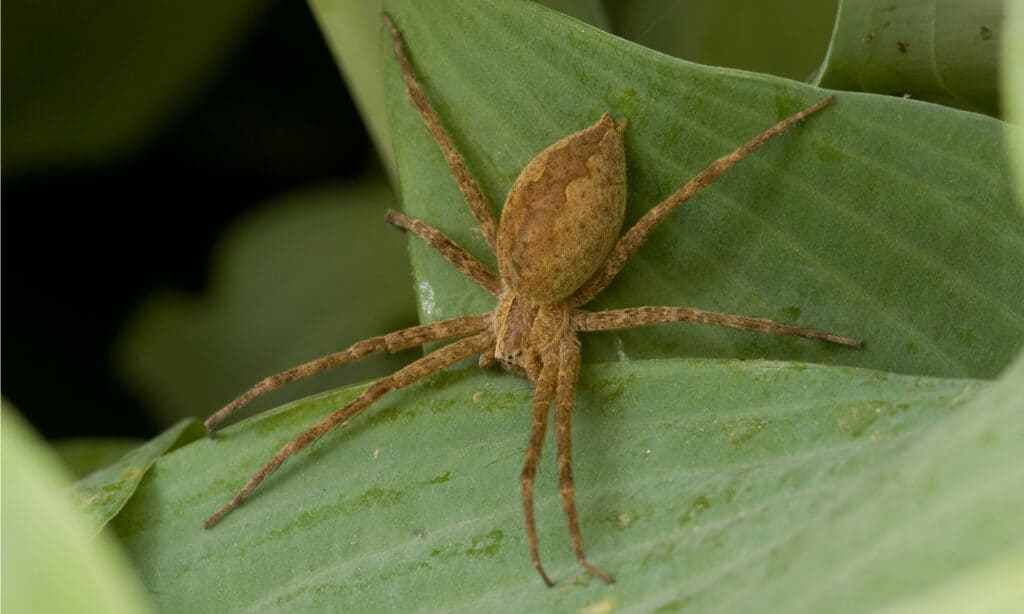
Female American nursery web spiders will attempt to eat their mates.
©SDeming/Shutterstock.com
| Scientific Name | Size | Danger to Humans |
|---|---|---|
| Pisaurina mira | 1-3 inches | Has a bite that is mostly harmless to humans, with pain and swelling common. |
The American nursery web spider has a unique name. This name comes from its instinctual building of a webby nursery when its eggs are ready to hatch. It is not the only spider that does this, though.
These nursery web spiders are also intriguing because they, like some other spiders, attempt to practice sexual cannibalism. That is the practice of eating their reproductive mate to gain nourishment. They live in tall grass or other vegetation like bushes and trees.
You may see them living around your home if you have tall vegetation. These spiders are easy to identify. They’re brown or reddish-brown with a darker brown stripe down the center of their entire body. Inside of that brown stripe is another darker brown mark in some cases. Also, the pattern may be outlined by a thin white line on the sides.
A bite from this spider isn’t very serious. You’ll feel pain and experience local swelling, but that’s all.
3. Carolina Wolf Spider
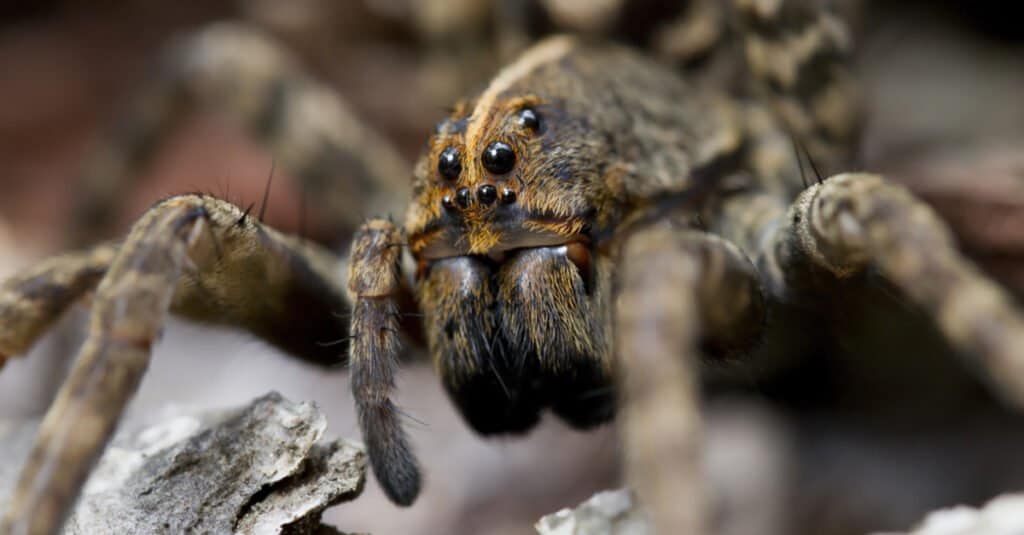
The Carolina wolf spider is the biggest member of its genus.
©Will E. Davis/Shutterstock.com
| Scientific Name | Size | Danger to Humans |
|---|---|---|
| Hogna carolinensis | 2-4 inches | The bite from this spider causes local pain and swelling. |
The Carolina wolf spider is the largest member of the genus in the United States and it can reach a length of 4 inches including its massive leg span. It is a wandering hunter that will lie in wait under the cover of tall grass, logs, rocks, and other things until prey walks by.
These spiders don’t wait to catch their prey with a web. They pounce on them and kill them quickly. They are fast and large, and that combination scares people when they see them. Carolina wolf spiders are usually brown with two dark stripes running from behind their highest eyes down their carapaces.
The outer edge and middle of the carapace are much lighter, but the spider also has dark patterns on its abdomen as well. Males may have orange coloring on the sides of the abdomen, but not all of them do. Their bite is painful and will usually swell.
Some people are allergic to wolf spider venom and will need medical attention for nausea, headaches, and other effects. Yet, most people are fine shortly after a wolf spider bite.
2. Dark Fishing Spider
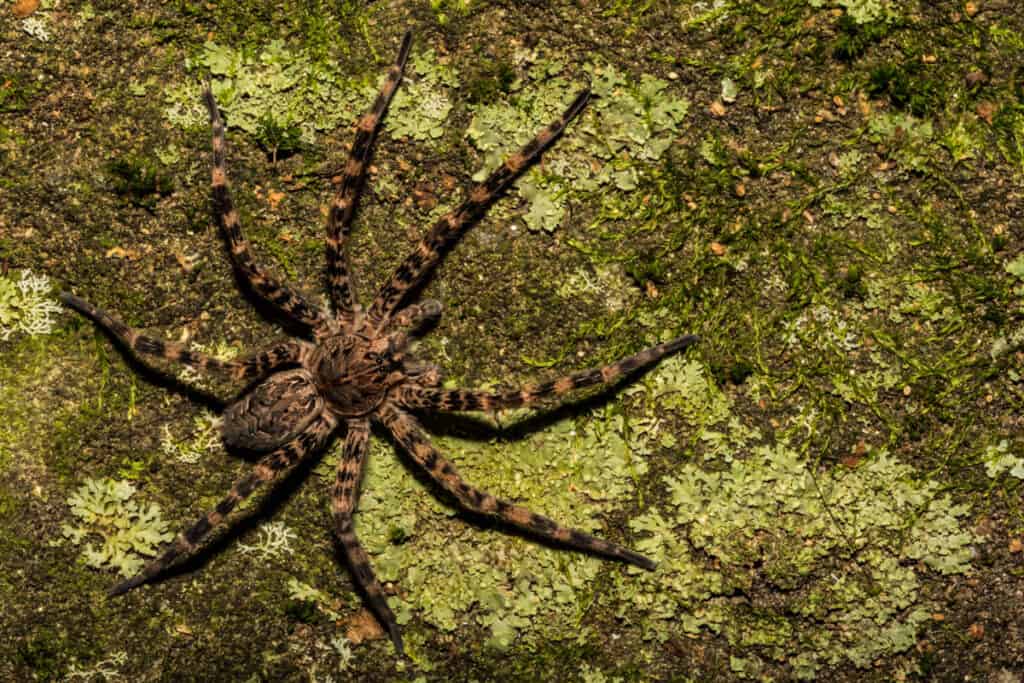
The dark fishing spider is one of the largest spiders in Oklahoma.
©iStock.com/JasonOndreicka
| Scientific Name | Size | Danger to Humans |
|---|---|---|
| Dolomedes tenebrosus | 3.5-4.5 inches | Can bite humans and cause a reaction similar to a bee sting. |
The dark fishing spider is tied as one of the biggest spiders in Oklahoma. It’s often mistaken for other spiders due to its size and the fact that it doesn’t stay near the water like other members of the Dolomedes genus. This spider is very large, with a leg span that measures over 4 inches and a body length that can measure over an inch.
Dark fishing spiders are often seen resting on trees near sources of water or walking along the ground. Their coloration is best described as mottled black and brown throughout their body. However, they have noticeable, dark, W-shaped patterns on their abdomens.
These spiders are skittish, so they will run when you get near them. If you manage to grab and handle one, it may bite you. That will lead to some pain that is similar to a bee sting, but you should not face many other complications.
1. Texas Brown Tarantula

Texas brown tarantulas have long fangs and can deliver a powerful bite.
©texas brown tarantula/Shutterstock.com
| Scientific Name | Size | Danger to Humans |
|---|---|---|
| Aphonopelma hentzi | 2-4.5 inches | Delivers a painful bite that leaves puncture wounds, swelling, and possible infection |
The Texas brown tarantula is the biggest spider in Oklahoma. It may be tied for the overall length, but tarantulas are fairly heavy spiders, so this one edges out the fishing spider. You may see a tarantula and worry that it’s going to do serious harm to you.
The truth is that its bite will hurt, the area will swell, and the resulting puncture wounds could get infected. However, the bite is not fatal.
The Texas brown tarantula has a brown carapace with reddish-brown hairs and a darker brown abdomen and legs. The legs can be very dark brown on the femur and may have light banding on them. These spiders are hairy on the abdomen and legs, but the hair is shorter on the carapace. They enjoy hiding under rocks, logs, and other forms of cover so they can ambush their prey. Texas brown tarantulas are dangerous to the insects and other creatures they hunt but not to humans.
Now that you know about the biggest spiders in Oklahoma, you probably realized that they’re not too dangerous. However, Oklahoma has two especially dangerous spiders. They are the brown recluse and the black widow. Both of them can deliver a potentially dangerous or even fatal bite, so you should respect them by maintaining your distance and getting aid in putting an end to an infestation.
Summary of 5 Biggest Spiders in Oklahoma
| Rank | Species | Size |
|---|---|---|
| 1 | Texas Brown Tarantula | 2-4.5 inches |
| 2 | Dark Fishing Spider | 3.5-4.5 inches |
| 3 | Carolina Wolf Spider | 2-4 inches |
| 4 | American Nursery Web Spider | 1-3 inches |
| 5 | Long-Bodied Cellar Spider | 1-2 inches |
Thank you for reading! Have some feedback for us? Contact the AZ Animals editorial team.

